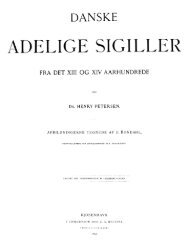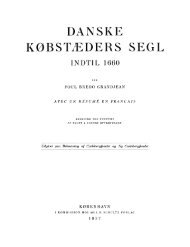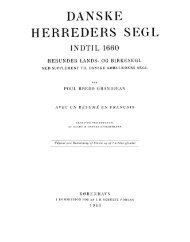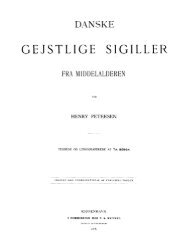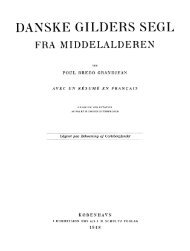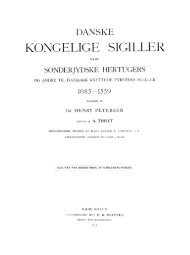Oldtidsagre - Genstandskundskab
Oldtidsagre - Genstandskundskab
Oldtidsagre - Genstandskundskab
Create successful ePaper yourself
Turn your PDF publications into a flip-book with our unique Google optimized e-Paper software.
156 Nr.1<br />
here at some time in the first century A. D., when the youngest houses were given<br />
up. In the locality Lunde 2 (No. 101, p. 17), cultivation was also probably continued<br />
in Roman Iron Age, as a couple of clay vessels from that period were found in one<br />
of the balks. In Svendstrup Hovgaards heath (No. 51, pp. 65-69), the “Oldtidsager"system<br />
must have continued into Late Roman Iron Age, as rotation-querns were<br />
found in some of the stone-heaps in the balks.<br />
It has not been possible to date any typical “Oldtidsager"-group in Demnark<br />
to a later period than Late Roman Iron Age. It must be admitted, however, that<br />
dating-material is known only from a minority of the localities. \Ve do not know<br />
with any certainly when the “Oldtidsager"-field-system was finally discarded in<br />
Denmark.<br />
\Ve may assume a near relation between the "<strong>Oldtidsagre</strong>“ and the primitive<br />
ancient plough, the arð. It is probable that the arð and the ancient field-system were<br />
still used for light sandy soil at a period when they had been discarded upon heavy<br />
clayey soil. The ancient field-system must have had undesirable effects on flat land<br />
with heavy soil; the basin-shaped fields would, in such regions, be exposed to imperfect<br />
drainage, especially when the moist subatlantic period had set in in the Early<br />
Iron Age. \Ve must assume that the ancient field-system agreed better with the comparatively<br />
dry subboreal climate of the Bronze Age. Therefore, it is an obvious<br />
possibility that the heavy plough with mould-board and the strip-fields, ridged in the<br />
middle (“Hochäcker”) may have prevailed in the more fertile parts of Denmark at<br />
a time when the arð and the basin-shaped fields were still retained in the less fertile<br />
sandy regions of our country.<br />
This line of reasoning is supported by the fact that the oldest find of a mouldboard<br />
plough in Denmark, the Tømmerby-plough, is dated pollenanalytically to the<br />
Early Pre-Roman Iron Age (STEENSBERG 1937, pp. 252 seqq.). It must be admitted,<br />
however, that we have not succeeded in dating any “Hochäcker" in Denmark to prehistoric<br />
time. Many of the deserted fields of the “Hochäcker"-type in Danish heaths<br />
and woods may safely be placed within historical times. In earlier publications<br />
(HATT 1930 a, pp. 353 seq., 1931, pp. 119-12O), I have set forth the supposition that<br />
the old deserted fields, mentioned by Saxo in the story about king Snjo and the<br />
emigration of the “Longobards", might be of the “Hochäcker"-type. It is, however.<br />
hardly admissible to regard this passage in Saxo's work as a proof of the existence<br />
of such fields; Saxo may also have thought of the remnants of prehistoric cultivations<br />
of the “Oldtidsager"-type, still visible in Topshøj forest, a locality which Saxo knew<br />
personally (cf. No. 117, pp. 117 seq.).<br />
As the mould-board plough must have existed in Denmark in Early Pre-Roman<br />
Iron Age-according to the pollenanalytical dating of the Tømmerby-plough-and as<br />
we have not been able to date any of our deserted fields of the “Hochäcker"-type<br />
to prehistoric times, I have attempted to associate the mould-board plough with a<br />
special type of “<strong>Oldtidsagre</strong>", the long and narrow form, which is known e. g. from<br />
Byrsted heath (HATT 1937, p. 10l). This is, however, hardly admissible. It is more



